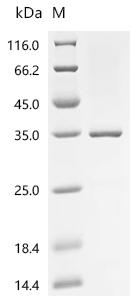Recombinant Human Retinoblastoma-associated protein (RB1) is produced in an E. coli expression system, covering amino acids 729 to 928 of the protein. This partial protein includes a C-terminal 6xHis tag, which helps with purification and detection in research applications. Purity exceeds 85% as verified by SDS-PAGE, which appears to ensure reliable performance in experimental setups. This product is intended for research use only.
Retinoblastoma-associated protein (RB1) functions as a crucial regulator of the cell cycle. It primarily controls the transition from the G1 phase to the S phase. The protein acts as a tumor suppressor by inhibiting cell proliferation, thus playing a significant role in maintaining genomic stability. This makes RB1 particularly valuable in cancer research and studies related to cell cycle regulation.
Potential Applications
Note: The applications listed below are based on what we know about this protein's biological functions, published research, and experience from experts in the field. However, we haven't fully tested all of these applications ourselves yet. We'd recommend running some preliminary tests first to make sure they work for your specific research goals.
Based on the provided information, the recombinant human RB1 fragment (729-928aa) is expressed in E. coli, a prokaryotic system generally unsuitable for producing functional eukaryotic tumor suppressor proteins. While this partial fragment represents a specific C-terminal region of RB1, it requires precise folding to maintain any potential domain integrity and interaction interfaces. E. coli lacks eukaryotic chaperones and post-translational modification machinery, making proper folding and phosphorylation status uncertain. The C-terminal 6xHis tag may further interfere with the native structure. Although the protein shows >85% purity, the expression system and unverified activity status mean the protein cannot be assumed to be correctly folded or bioactive without experimental validation of its structure and function.
1. Protein-Protein Interaction Studies Using Pull-Down Assays
The His-tag enables technical feasibility for pull-down experiments. However, if the RB1 fragment is misfolded, it will not maintain physiological interaction interfaces. The 729-928aa region may contain binding sites that require a specific conformation. Identified interactions could be non-physiological without proper folding validation. This application carries a high risk without prior confirmation of the native structure.
2. Antibody Development and Validation
This application remains appropriate as the safest use case. The recombinant fragment can generate antibodies recognizing linear epitopes within the 729-928aa region, even if misfolded. The His-tag facilitates purification and screening. However, antibodies may not recognize conformational epitopes of properly folded, full-length RB1 in cells. Validation against endogenous RB1 is essential.
3. Biochemical Characterization and Stability Studies
This application is well-suited for initial characterization. Biophysical techniques (circular dichroism, size-exclusion chromatography) can directly assess folding state and stability. These studies are valuable even if the protein is inactive, providing crucial data on the recombinant product's properties before functional applications.
4. Competitive Binding Assays
This application is highly problematic without folding validation. If the fragment is misfolded, binding interfaces for small molecules or peptides will not resemble native RB1. Screening efforts may identify compounds binding to non-physiological conformations. This requires prior demonstration of proper folding and binding capability.
Final Recommendation & Action Plan
Given the uncertainties in folding and functionality, recommend a stepped approach: First, perform biophysical characterization (circular dichroism for secondary structure, analytical ultracentrifugation for oligomeric state) to assess folding quality. Antibody development can proceed as the lowest-risk application. Avoid all interaction and binding studies until proper folding is confirmed. For reliable functional data, validate using known RB1 binding partners if possible. Always include appropriate controls and consider using full-length RB1 from eukaryotic systems for critical functional studies. The partial fragment may be most suitable for structural studies and domain-specific antibody production rather than full functional analysis.






